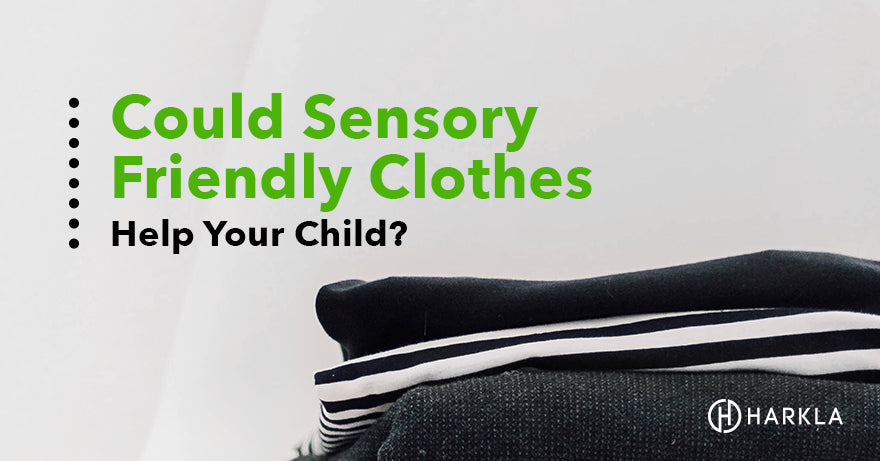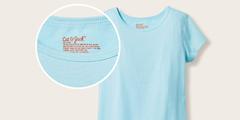Your Cart is Empty

Do you have a child who is sensory sensitive or has sensory differences? Does he or she have a strong preference or dislike of certain fabrics or clothing textures?
For my own son, he hasn’t worn jeans in years and insists on wearing the same, soft sweatshirt to school every single day. This is mainly because of a dislike of stiff, hard denim, and a preference for soft, stretchy material.
Other tactile sensitivities kids might experience with clothing include elastic waistbands, tags, and seams. Each child is different, and their clothing preferences may not make sense to you.
These issues with clothing are most likely part of a larger sensory processing disorder. You can read our guide on SPD to learn more about sensory processing.
Accommodating a child's needs with sensory-friendly clothing will make them feel more comfortable and less anxious, which in turn is sure to make your life easier.

If you’ve read our article, A Guide to Sensory Processing Disorder, then you know that many kids with SPD experience sensory defensiveness. This is an inability to tolerate certain types of sensory stimulation.
Things that most kids don’t think twice about, like the pants or socks they put on each day, can cause children with SPD to feel overwhelmed and anxious. Signs of sensory defensiveness are usually obvious and can include sensitivities to all of their senses, not just tactile (touch). Children may have difficulty tolerating certain food textures or tastes, loud noises, and even certain visual stimuli.
If you suspect your child has SPD, and struggles with sensory defensiveness, you should discuss your concerns with your child’s occupational therapist. There are many therapeutic activities that can help.
In the meantime, making simple changes like using special sensory clothing can quickly and easily ease some of your child’s stress triggers.
In recent years, with the growth of the autism acceptance movement and an emphasis on meeting the needs of kids with autism and SPD, the sensory clothing market has gained popularity and for good reason.
When you use sensory-friendly clothes, your kid’s dressing routine can be drama free!
Here are five great options to check out:



Kozie Clothes was founded by a pediatric occupational therapist and offers a variety of sensory-friendly tops, bottoms, socks, and swimwear. They make their clothing items with tear-away tags, inverted seams, and use soft cotton.
Spio stands for Stabilizing Pressure Input Orthosis. It’s a unique line of compression clothing that was designed through research and “assists patients with stability and proprioceptive deficits through deep pressure”. It is specifically made for those with special needs, including autism and sensory processing disorder. This is a great option to wear under clothing that has tags or seams.
Smart Knit Kidsoffers underclothes and socks that are soft, tagless, and seamless. They also have a compression t-shirt that hugs the torso and provides gentle compression.

Cat and Jack's sensory line of clothing, sold at Target, is “soft, easy & comfy… made to minimize discomfort & maximize fun.” There are soft seams and no tags. You'll find cool styles that many kids will love and a real PLUS is that it’s affordable!
 Hanna Andersson is known for high quality, durability, and an unconditional guarantee. All clothing options have soft seams and are made of super soft material so your child won’t feel like their clothes are “scratchy”.
Hanna Andersson is known for high quality, durability, and an unconditional guarantee. All clothing options have soft seams and are made of super soft material so your child won’t feel like their clothes are “scratchy”.
Their pajamas are fitted and very comfortable for kids of all ages. There is even a large selection of organic items, too.
Sensory-friendly clothes may help ease the stress your child experiences during his or her dressing routine.
If you have a child with sensory issues who is struggling to get dressed everyday and hating their clothes, taking a look at the brands above would be helpful!
If you've already had success, let us know, and if you have a favorite sensory-friendly clothing brand, we'd love to hear from you. Let us know in the comments!
Morris, M., (2004). Sensory Defensiveness. Sensory Processing Disorder. Retrieved from http://www.sensory-processing-disorder.com/sensory-defensiveness.html
Comments will be approved before showing up.


Amy Ward
March 24, 2023
It seems like the companies that have sensory friendly clothing are only for children. My daughter is now 17 and it is getting harder and harder for her to find clothing that works. What is available for older kids/adults? We have been in what I call “a sensory spiral” for months now, it is completely debilitating.